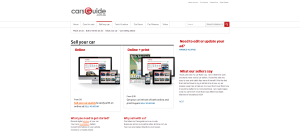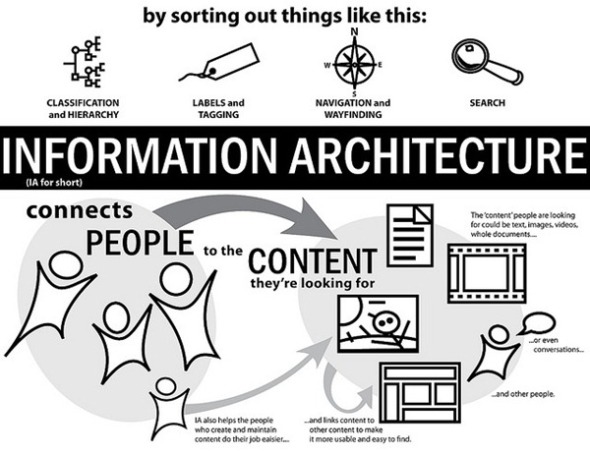Take a screen capture of the main page of web site of your own choice and post it on your blog. Create a table (similar to page 101 of Morville – Chapter 6) describing the navigational labels. The table should present the name of the label, the destination page’s heading label, and the destination page’s <TITLE> label.
I decided to do Carsales.com.au due to recently browsing the site, having some familiarity with it, the current popularity of the site and it being (what I consider to be) a well designed and labelled website.
Name of Label |
Destination Page’s Heading Label |
Destination Page’s <TITLE> Label |
|
Top-of-page navigation system labels |
||
|
Cars for sale |
Cars for sale |
Used Cars – New Cars- Search New and Used Cars for Sale – carsales.com.au |
|
New car showroom |
New car showroom |
New car showroom- carsales.com.au |
|
Sell your car |
Sell your car |
Sell your car- Australia No1 Autosite 3.4 Million Buyers- carsales.com.au |
|
Parts & Services |
Accessories |
Car Parts & Accessories- Search New & Used Car Parts & Accessories – carsales.com.au |
|
Research |
Research |
Car Reviews & Research – carsales.com.au |
|
News & reviews |
News & reviews |
Car Reviews- Read Car Reviews, News Car Advice Online – carsales.com.au |
|
Help |
Help |
Help Center – carsales.com.au |
|
Our sites |
Our sites |
Car Sales Network- carsales.com.au |
|
Sign in |
Sign in |
Sign in – carsales.com.au |
|
Join |
Join |
Join – carsales.com.au |
|
Bottom-of-page navigation system labels |
||
|
Terms & conditions |
Terms & conditions |
Terms & conditions- carsales.com.au |
|
Privacy |
Privacy |
Privacy Policy – carsales.com.au |
|
Contact us |
Contact us |
Help Centre- carsales.com.au |
|
Editorial team |
Editorial team |
Editorial team – Read Car Reviews, News & Car Advice Online- carsales.com.au |
|
About us |
About us |
About us- carsales.com.au |
|
Careers |
Careers |
Carsale Careers – Career Opportunities and more! – carsales.com.au |
|
Corporate advertising |
Corporate advertising |
Find the right online advertising solution for your business – Home- MediaMotive |
|
Competitions |
Competitions |
Carsales People’s Choice Awards – carsales.com.au |
|
Shareholders |
Shareholders |
Shareholders Centre home– carsales.com.au |
|
Site map |
Site map |
Site map- carsales.com.au |
|
Popular searches |
Popular searches |
Popular searches- Carsales.com.au- carsales.com.au |
a. What labels you did not like and why, and suggest improvements.
Personally, I found the site to be well designed with a consistent, easily navigable and a visually appealing colour scheme. The sites purpose is to advertise cars and various related products and the site obliges this by allowing a user to go online, easily access the desired information and content (not an intentional course namedrop) without unnecessary effort and minimal hassle. I can’t suggest any improvements per say as the website is both effective and manages its use of labels well.
b. Whether there were any inconsistencies in the labelling system between the pages (in terms of style, presentation, syntax, granularity, comprehensiveness and audience).
Style– The overall website style and appearance is very well designed with a professional and cohesive appearance. A user can browse the website in its entirely but still be presented with the same core page with the elements remaining the same and the content changing. Due to this, Carsales is extremely user friendly and stylistically appealing and this has resulted in it being the most popular Carsales website within the Australian community.
Presentation– The site presents itself very well with the site having plenty of information and links without feeling overpopulated with irrelevant content. Numerous other sites attempt to combine multiple types of navigation methods (such as sidebars as well as top of page menus) but Carsales has a simple and effective layout and this is retained regardless of whatever page of the site you are linked to.
Overall the sites presentation featured no notable inconsistencies with font sizes and types being the same throughout and making an effective yet not cramped use of available space, though this is to be expected due the sites current popularity and (presumably) high budget design and implementation.
Syntax– The site had excellent syntax as each of menu links is clear and describes precisely what the user will be navigated to which attributes to the overall positive user experience. Again, this can be contributed to the sites popularity which would ensure that it is easily navigable for its market, which includes people from a wide range of demographics. In terms of its heading labels, Carsales sticks primarily to nouns and this is beneficial as it retains a certain cohesiveness by not branching out to other syntactical approaches.
Granularity– Carsales presents itself very well overall and has a high level of technical details. The labels each have a unique purpose and seldom overlap into the same topics/links. The labels possess the same level of granularity and are specific enough to allow the user to know what it is they are clicking on.
Comprehensiveness– I personally found the site to be very comprehensive covering all major and several minor aspects that a user may want and/or need to know when buying or selling a car and based off my observations, they have done an exemplary job of deciding what requires its own subsection. The appropriate and more prominent/popular sections had a label for quick access and the less prominent areas were contained within sub-sections though not to the point of being confusing. Unless the user is seeking something unusually specific, all the information required is available somewhere on the website and should be relatively simple to locate.
Audience– Carsales.com has a very wide audience in terms of those who frequent the site as nearly everyone will at some point require a motor vehicle, however, every visitor comes with a specific purpose. Usually it is either with the intent of buying a car or selling a car and based off this knowledge, Carsales has managed to tailor the site to its audience very well. The site employs understandable terminology and avoids technical jargon for inexperienced users and has created a navigation system which can be easily used by its entire target market assuming they have the base knowledge to access the site and are aware of what it is they are seeking.
c. Examine at least two other similar or competing web sites. How similar are the labelling systems? Is any one site clearly the winner (and if so, why)?
I selected CarGuide (http://www.carsguide.com.au/) and CarsWanted (http://www.carswanted.com.au/) which are both Australian based online Car retailers providing essentially the same service that Carsales does. These websites are therefore direct competitors in the market and have similar though subtly different labels based off observations made from the respective sites.
While these three sites possess similarities, due to providing the same function, there are also obvious differences once a close look is taken, CarsWanted is more a business orientated website offering only Home, About, How It Works, Where We Buy and FAQ in the top-of-the-page navigation system labels whilst CarGuide is very closely resembling Carsales with labels for Reviews and Tools & Advice.
The bottom-of-page navigation system labels for CarsWanted differ from the other two websites due to possessing them previously in the top-of-page navigation. This decision is a logical one as having two of the same links in different places would be unnecessary and may cause some issues with viewers who are familiar with the more popular sites. That being said, this does deter greatly from the overall site navigation and accessibility.
CarGuide on the other hand has bottom-of-page labels which bear a striking similarity to Carsales, with the labels and links being nearly identical and even being ordered the same.
From these observations it is safe to assume that numerous other eCar retailers will follow a labelling structure in the same vein as Carsales and based off its success; it is clearly effective.
While each of these separate sites have positive and negatives, based on personal preference, I believe Carsales is the clear winner out of the trio for a couple of reasons and these may contribute to why Carsales is the most well-known and prominent out of the three with the general public and audience agreeing on some level (even subconsciously) with my thought process.
Neither CarGuide nor CarsWanted have a very well implemented menu labelling system, with the labels not remaining at the top of the web page when scrolling which limits the user’s access and forces them to manually scroll up if they wish to navigate around the website.
Additionally, the colour scheme is not cohesive or aesthetically appealing with CarsGuide having a white on white scheme and CarsWanted having a grey on grey design. While these are not necessary bad choices, CarSales possesses a distinctive black menu with contrasting white labels making them easily apparent and visible to the users. Finally, the Carsales site simply looks better, it has a simple yet distinctive visual appeal that these other sites have failed to induce or replicate.
d. Look at how other students have answered this question and comment on their blogs.
Will Update At A Later Date








